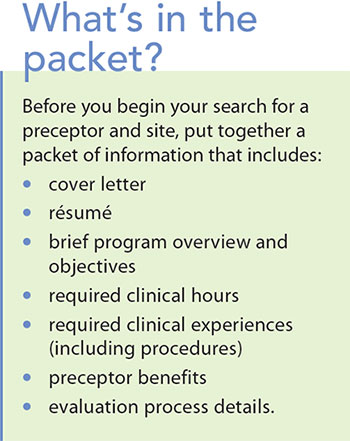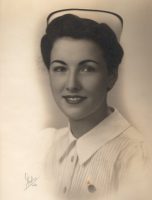Preparation and perseverance will help you find the right preceptor and site.
Takeaways:
- Before beginning your preceptor search, know your school and specialty requirements for clinical preceptors.
- Perseverance is key to a successful preceptor search.
By Ginny Moore, DNP, WHNP-BC, and Sharon Fleming, DNP, PNP-PC


Many graduate NP programs require students to secure their own clinical sites and preceptors. The process can be challenging and frustrating, but taking an organized approach will help you find a preceptor in your preferred clinical setting.
Understand the requirements
Before starting your search for a preceptor and clinical site, learn about your school’s requirements. The certifying body for your specialty and your school’s credentialing organization determine the requirements for who may serve as a preceptor. Some specify that only an NP certified within your specialty may act as a preceptor, whereas others permit NPs outside of your specialty or providers (physicians, physician assistants) outside of your discipline. Knowing this information will help you narrow or broaden your search as necessary.
Site requirements may be defined by certifying and credentialing agencies and the individual program in which you’re enrolled. Inpatient settings, outpatient clinics, private practices, health departments, and urgent care clinics are examples of sites that may be specified or excluded. The clinical coordinator for your program can help you identify settings most appropriate for your learning objectives.
Prepare a preceptor packet


Prepare a packet of information to share with potential preceptors and sites. (See What’s in the packet?)
Your cover letter should include how you learned about the practice and what you’ve heard about it. For example, if you were referred by someone, such as a classmate or a current patient who had positive experiences, include that information. And if the organization’s mission statement resonates with you, include that as well. Remember this information and share it again during the interview process.
Some schools offer preceptor benefits in the form of monetary compensation, library privileges, workshop offerings, or adjunct faculty positions. Find out what benefits your school offers and include them in your preceptor packet.
Begin your search
After you’ve researched the requirements and prepared your preceptor packet, you can begin your search.
Get organized
Prepare a chart for documenting the details of your search. Include agency names, dates of contact, names and titles of who you spoke with or left messages for, and conversation or message details.
Choose sites
The final list of sites you plan to contact should be those with a practice philosophy and care approach that resonate with you. If they have a mission or vision statement posted on their website, make sure it matches yours. You don’t want to be in a practice with goals contradictory to yours.
You’ll rely on your personal experiences to create the list, but you’ll also want some outside input. Check in with family, friends, and colleagues to help you decide if a particular site or provider is
a good match for you. Other resources include your school faculty, program alumni, and clinical coordinator. If you know where you want to practice after graduation, do an online search of practices in that area.
Practices that already have NPs may be more open to precepting NP students. But if these types of practices aren’t an option, be a trailblazer and introduce the benefits of NPs.
Document as much information as you can about each practice on your list. You’ll want to refer to these specifics when you start making contact.
Make contact
Your initial contact—by phone or email—with potential sites will depend on personal preference and circumstance. If you’re calling, avoid busy times of the day, such as when the site is opening or closing. If you’re searching in distant areas, your only contact may be by phone or email; for closer locations, make an in-person visit.
For in-person visits, call ahead and ask the receptionist the best time to visit and, if possible, make an appointment with the practice manager. Dress professionally and take your information packet to leave behind for the manager or provider.
Your objective for any method of contact is to determine whether the practice is willing to precept a student and the most appropriate person to speak with about a clinical placement. That person may be the provider, office manager, or administrator.
Prepare a script of consistent information to share with each site. Introduce yourself and explain why you’re contacting the practice. Follow with a positive statement about the practice or provider. This statement may be based on your personal experience, positive feedback from patients, or a sense of connection with the mission statement. Individualize the introduction for each practice you contact. After the introduction, your script should contain consistent information about your program requirements and course objectives. Conclude by asking when you can expect a response to your request.
Follow up
After contacting each practice, send a thank-you email or note within 3 to 5 days. You want the practice to remember you, but you don’t want to make contact too soon or too often. If you call, let the receptionist know that you’re following up and who you spoke with previously. Express gratitude for any and all assistance you receive.
Persevere
Preparation, though time-consuming, is key to finding a preceptor. Expect to make contact with several practices before securing a site. This is just the nature of the process. Perseverance coupled with a positive attitude will eventually lead to a successful clinical placement.
Janie follows the advice in this article, and her preparation and organization pay off. She finds a preceptor and clinical placement that aligns with her professional goals and meets her specialty and school requirements.
The authors work at Vanderbilt University School of Nursing in Nashville, Tennessee. Ginny Moore is an associate professor of nursing and director of the women’s health nurse practitioner specialty. Sharon Fleming is a clinical instructor and clinical coordinator in the pediatric nurse practitioner primary care program.
Selected references
American Association of Colleges of Nursing. (2016). Curriculum standards.
Krall LM. The trouble with finding a preceptor. Clinical Advisor. February 26, 2013.
National Organization of Nurse Practitioner Faculties. Competencies for nurse practitioners.
ant2-Focus 0n EDUCATION-123



















1 Comment.
Help. I need a FNP preceptor for my upcoming pediatric rotation May 2020 in S.C., NC, GA, or TN!